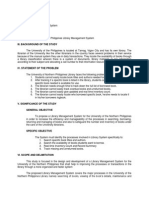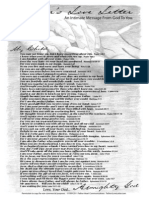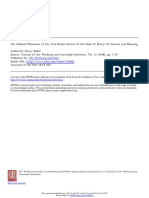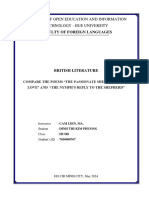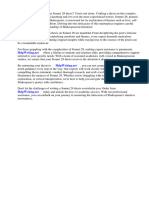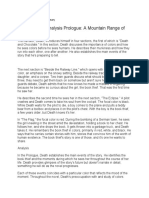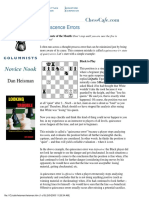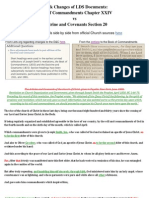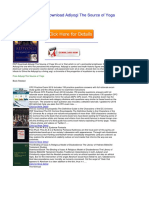The Passionate Shepherd To His Love
The Passionate Shepherd To His Love
Uploaded by
Joseph GutierrezCopyright:
Available Formats
The Passionate Shepherd To His Love
The Passionate Shepherd To His Love
Uploaded by
Joseph GutierrezOriginal Title
Copyright
Available Formats
Share this document
Did you find this document useful?
Is this content inappropriate?
Copyright:
Available Formats
The Passionate Shepherd To His Love
The Passionate Shepherd To His Love
Uploaded by
Joseph GutierrezCopyright:
Available Formats
Roy Chan SID: 94105908 October 22, 2007
The Shepherd Cries For True Love
Are the heart and the mind contradictory from a desire and an illusion? In the poem, The Passionate Shepherd to His Love, Christopher Marlowe, a highly acclaimed English poet, evokes the natural world of a shepherds life whose temptation is to fall in love with an object known as the Nymph. The poem, which is composed in iambic tetrameter form, is interesting in that the poet never mentions to the reader whether there are any clear history between the two; whether there are any evidence that the shepherd wanted to be in love with the Nymph; nor whether there are any declaration made of him offering up marriage or love to the Nymph in the near future. This is interesting because Marlowe does indicate to the reader that the shepherd wanted the Nymph to come and seek a love relationship with him; however, the poet never exclaims to the audience whether the womans reply is ever heard, thus making the Nymph presence unknown to the reader at times. Marlowe poem is thought-provoking because it reminded me of a 19th century French writer, politician, and diplomat Francois-Auguste-Rene de Chateaubriand when he once states, As long as the heart preserves desire, the mind preserves illusion. Chateaubriand, who is the founder of romanticism in French literature, implies that our mind would continue to have a false impression in life as long as the heart maintains desire. The shepherd, whose intention is to fall in love with a Greek mythology, has a strong desire to not fall out from his love toward the Nymph because of how his mind preserves illusion. The shepherd never wanted to fall out to the other side of love; so he therefore continues to interact with the Nymph in hopes that she would recognize that his heart and mind toward her is unconditional, and that his desire and illusion with the Nymph would one day intercede together in the near future. Marlowe hence composed
Roy Chan SID: 94105908 October 22, 2007 the poem utilizing a four feet of unstressed and stressed syllables to vividly describe the desire and the illusion in The Passionate Shepherd to His Love to represent a contrast between the heart and the mind, ultimately suggesting that the heart and the mind is correlated to the shepherds failure and intention to interact with the love object known as the Nymph So the question arises: how do the literary form and the content of the poem relate to the shepherds failure and intention to interact with the Nymph? The poem, which is written during the Elizabethan era, uses a pastoral content to explicate the lifestyle of a shepherd who worked very hard in the countryside with other farm workers. An example of a pastoral content is in line 5 when the poet writes And we will sit upon the rocks, Seeing shepherds feed their flocks; By shallow rivers to whose falls, Melodious birds sing madrigals. Like this, writing in a pastoral tradition generally meant that the tone of the poem is characterized by the state of comfort and of romantic love as if the shepherd believes that everything would work out very well between him and his love. An example of how the shepherd is very certain that he would fall in love with the Nymph is in line 13 when the narrator writes A gown made of the finest wool, Which from our pretty lambs we pull. Another is in line 19 when the poet writes And if these pleasures may thee move, Come live with me and be my love. Both of these illustrate how the shepherds life is filled with great awe and that the shepherd is confident that he would one day fall in love with the Nymph. Most pastoral poems during the third century depict the ideal of sexuality and eroticism - that they convey images of humans desire and temptation to fall in love with an object. Hence, the shepherd and the Nymph probably had a desire and an illusion to fall in love with one other, ultimately suggesting that those
Roy Chan SID: 94105908 October 22, 2007 two attributes represent the contrast between the heart and the mind intentions to fall into love together. Aside from the pastoral content, the iambic tetrameter help makes the structure of the poem to contain rhyme schemes throughout the poem. A rhyme scheme can be described as the pattern in which the rhymed line-endings are arranged in a poem or stanza (Baldick, 219). An example of a rhyme scheme is on line 21, when the poet writes The shepherd swains shall dance and sing, For thy delight each May morning. In the sentence, we could see that the rhymed line-endings of sing and morning rhymes together. Other sentence like in line 1 is when the ending had love and prove, and fields and yields. This pattern can be seen throughout the poem as all the stanza consisted of various patterns in rhyme scheme. It is this type of form and content that helps the reader understand more about the theme between the shepherd and the Nymph. One can say that the theme in the poem could be described as taking life as a leisure and relaxation. An example is in line 5 when Marlowe writes And we will sit upon the rocks, Seeing the shepherds feed their flocks. This sentence can be seen as us having unlimited freedom with nature in order for the poet to convey the images of the shepherds desire and illusion to have freewill with the Nymph. Despite the rhyme scheme and pastoral content, the iambic tetrameter used throughout the poem makes the description of love between the shepherd and the Nymph become more relevant to the heart and the mind. The utilization of the rhyme scheme and the pastoral form makes the poem to be interesting in that it does not use the form of enigmatic but rather something to be more obvious and apparent to the reader. Marlowes poem reminds me of French writer Franois de La Rochefoucauld when he believes that
Roy Chan SID: 94105908 October 22, 2007 the actions of men and women are motivated solely by their own advantage and self interest. He believes that Self-love is love of oneself and of all things in terms of oneself; it makes worshippers of themselves and would make them tyrants over others if fortune gave them the means (Rochefoucauld, 43). In other words, he believes that to love one self is the beginning of a lifelong romance. Though the poet never proclaims that the Nymph loved the shepherd, the shepherd probably knew that having a love relationship with the Nymph could be a start of a lifelong romance. His love is viewed similar to Dutch philosopher Baruch Spinoza when he states that Love is nothing else but pleasure accompanied by the idea of an external cause (Morgan, 23). Needless to say, this quote reflects that love is just accompanied by the idea of an external cause, and that love between the shepherd and the Nymph is nothing more but a desire and an illusion in order to represent the contrast between the heart and the mind, ultimately suggesting that the heart and the mind is correlated to the shepherd failures to interact with his love object, the Nymph.
Roy Chan SID: 94105908 October 22, 2007 Reference Baldick, Chris. The Concise Dictionary of Literary Terms. New York: Oxford University Press, 2004. Ferguson, Margaret. The Norton Anthology of Poetry. New York: W. W. Norton, 2004. Morgan, Michael. The Essential Spinoza: Ethics And Related Writings. New York: Hackett Publishing Company, 2006. Rochefoucauld, Franois. Reflections; or Sentences and Moral Maxims. New York: Dodo Press, 2007.
You might also like
- The Architecture of ImageDocument1 pageThe Architecture of ImageLuka Knezevic0% (2)
- Thesis Library Management SystemDocument2 pagesThesis Library Management SystemGabriel Dela Fuente82% (45)
- Figures of Speech in Good MorrowDocument4 pagesFigures of Speech in Good MorrowMuhammad Mussawar67% (3)
- 21 Love PoemsDocument2 pages21 Love PoemsNidal ShahNo ratings yet
- Easy True StoriesDocument10 pagesEasy True Storiesntd2521998No ratings yet
- My Child... : Father's Love LetterDocument1 pageMy Child... : Father's Love LetterJohn Derick Bojo Hugo SabioNo ratings yet
- Harry Bober, The Zodiacal Miniature of The Très Riches Heures of The Duke of BerryDocument46 pagesHarry Bober, The Zodiacal Miniature of The Très Riches Heures of The Duke of BerryJefferson de Albuquerque100% (1)
- VCCS Bookstore RFPDocument43 pagesVCCS Bookstore RFPrichardsebastianNo ratings yet
- The Passionate ShepherdDocument15 pagesThe Passionate Shepherdriley2011No ratings yet
- 16-Nguyễn Thị Bích Vân-7054700176Document7 pages16-Nguyễn Thị Bích Vân-7054700176e7054700176100% (1)
- Thesis Statement For The Passionate Shepherd To His LoveDocument8 pagesThesis Statement For The Passionate Shepherd To His Lovednhrm565100% (1)
- British Literature 1 1. The Passionate Shepherd To His LoveDocument12 pagesBritish Literature 1 1. The Passionate Shepherd To His LoveMinh TâmNo ratings yet
- 1003 Claudio Literary-AnalysisDocument6 pages1003 Claudio Literary-AnalysisMarc PacaoNo ratings yet
- William Shakespeare's "Sonnet 18" AnalysisDocument3 pagesWilliam Shakespeare's "Sonnet 18" AnalysisAriq DhiaulhaqNo ratings yet
- My BookDocument9 pagesMy Booklinhmuy2403No ratings yet
- Sonnet 29 ThesisDocument6 pagesSonnet 29 Thesisfjgmmmew100% (2)
- 16 Century Poetry (Renaissance) 1500-1660Document22 pages16 Century Poetry (Renaissance) 1500-1660gashben farukNo ratings yet
- The Passionate Shepherd To His Love PROSEDocument3 pagesThe Passionate Shepherd To His Love PROSERoland Bon IntudNo ratings yet
- Assigment 1 of LCDocument4 pagesAssigment 1 of LCDiksha JhaNo ratings yet
- Assignment Canonization As A Metaphysical Poem - CompressDocument9 pagesAssignment Canonization As A Metaphysical Poem - Compressboz100% (1)
- Narrative and Poetry in Marlowe's The Passionate Shephered To His Love"Document3 pagesNarrative and Poetry in Marlowe's The Passionate Shephered To His Love"andreea1408No ratings yet
- On English Poetry: Being an Irregular Approach to the Psychology of This Art, from Evidence Mainly SubjectiveFrom EverandOn English Poetry: Being an Irregular Approach to the Psychology of This Art, from Evidence Mainly SubjectiveNo ratings yet
- Poetry Analysis - PerezDocument2 pagesPoetry Analysis - PerezJulia Stefanel Perez0% (1)
- Sonnet 6Document4 pagesSonnet 6Brahmankhanda Basapara HIGH SCHOOLNo ratings yet
- Daryna Borovets Group 2.3 Definition of Conceit: Extended MetaphorDocument5 pagesDaryna Borovets Group 2.3 Definition of Conceit: Extended MetaphorDaria BorovetsNo ratings yet
- Christopher MarloweDocument6 pagesChristopher Marlowelizafernandez126No ratings yet
- The Concept of Love in Shakespearean SonnetsDocument6 pagesThe Concept of Love in Shakespearean SonnetsShreya RoyNo ratings yet
- Analysis of The Definition of Love by Andrew MarvellDocument10 pagesAnalysis of The Definition of Love by Andrew MarvellMd Tazbir0% (1)
- John DonneDocument9 pagesJohn DonneHammad Ur rahmanNo ratings yet
- MultimodalDocument10 pagesMultimodalconnorNo ratings yet
- Day 1 - PoetryDocument32 pagesDay 1 - PoetryShafnaNo ratings yet
- The Cannonization by John DonneDocument10 pagesThe Cannonization by John DonnestanleyjohnfNo ratings yet
- The Double FlameDocument161 pagesThe Double FlameMilan Markovic MatthisNo ratings yet
- The Passionate Shepherd To His LoveDocument11 pagesThe Passionate Shepherd To His LoveJimarie Lim BitoyNo ratings yet
- Notes of Poetry MA (English) Sem-1Document14 pagesNotes of Poetry MA (English) Sem-1Parm PreetNo ratings yet
- PastoralDocument5 pagesPastorallooloofarNo ratings yet
- Analysis - MidtermDocument5 pagesAnalysis - MidtermEstella GalveNo ratings yet
- To His Coy MistressDocument8 pagesTo His Coy Mistressannalee.rnjNo ratings yet
- 1the Passionate Shepherd To His LoveDocument8 pages1the Passionate Shepherd To His LoveBen AbellaNo ratings yet
- Literature DramaDocument7 pagesLiterature DramaAmalin AhmadNo ratings yet
- Conversations with Quijote: A Poet's Decades-Long Quest to Reconcile His Ideal Love Affair with RealityFrom EverandConversations with Quijote: A Poet's Decades-Long Quest to Reconcile His Ideal Love Affair with RealityNo ratings yet
- The Canonization by John DonneDocument15 pagesThe Canonization by John Donnepmppl22No ratings yet
- Jacayl Dhiig ArticleDocument14 pagesJacayl Dhiig Articleazakariye346No ratings yet
- Anne Hathaway t45gcrDocument6 pagesAnne Hathaway t45gcrjemyNo ratings yet
- A Comparison Between Romantic Poetry andDocument4 pagesA Comparison Between Romantic Poetry andSonia AkhtarNo ratings yet
- Shakeaspeare SonnetDocument4 pagesShakeaspeare Sonnetehsanul1No ratings yet
- Donne CanonizationDocument3 pagesDonne CanonizationMalakNo ratings yet
- The Canonization by John Donne - Critical Analysis - Everything in One PDFDocument8 pagesThe Canonization by John Donne - Critical Analysis - Everything in One PDFliteraturelove30No ratings yet
- Meg 1Document6 pagesMeg 1Debasis DashNo ratings yet
- Reading Poetry PDFDocument25 pagesReading Poetry PDFABEER P MNo ratings yet
- Aesthetichal Value AnalysisDocument16 pagesAesthetichal Value AnalysisfaisalrizzaNo ratings yet
- Love Ideologies in Classical Arabic LiteratureDocument4 pagesLove Ideologies in Classical Arabic LiteratureRebeca Andrea Orellana CaprilesNo ratings yet
- The Last Ride Together by Robert BrowningDocument32 pagesThe Last Ride Together by Robert BrowningAhla IqbalNo ratings yet
- 11566723609Document4 pages11566723609SIRAJUL ISLAMNo ratings yet
- Elizabethan SonnetsDocument5 pagesElizabethan Sonnetsrngband11No ratings yet
- Literary PiecesDocument20 pagesLiterary PiecesAlyzza DhelNo ratings yet
- The Good MorrowDocument7 pagesThe Good MorrowZakaria Abu Syed100% (1)
- S - My-Literary-AnalysisDocument3 pagesS - My-Literary-AnalysisAlan Christian NeisNo ratings yet
- Major Themes in Shakespeare's SonnetsDocument7 pagesMajor Themes in Shakespeare's SonnetsVeresa Sandra50% (4)
- Earl of SurreyDocument7 pagesEarl of SurreyJasmin Al-salehNo ratings yet
- OceanofPDF.com the 100 Best Poems of All Time - Leslie PockellDocument247 pagesOceanofPDF.com the 100 Best Poems of All Time - Leslie Pockellpipincorn07No ratings yet
- Practical class 4Document10 pagesPractical class 4Мери ГерасименкоNo ratings yet
- Shakespeare's Treatment of Love and Romance in 'A Midsummer Night's Dream' EditedDocument5 pagesShakespeare's Treatment of Love and Romance in 'A Midsummer Night's Dream' EditedSABARI R C1594No ratings yet
- Diction On The Poem To His Coy MistressDocument10 pagesDiction On The Poem To His Coy MistressPrettyChanelNo ratings yet
- Shakespeare Trabajo RedactadoDocument6 pagesShakespeare Trabajo Redactadodarkelf4No ratings yet
- Renaissance Court Dance in Italy and France: A Short SummaryDocument17 pagesRenaissance Court Dance in Italy and France: A Short SummaryUlises Sanecrab100% (3)
- Exploring Dimensional Quilt Art BLAD WebDocument8 pagesExploring Dimensional Quilt Art BLAD WebInterweave100% (2)
- The Book Thief Chapters SummaryDocument60 pagesThe Book Thief Chapters SummaryAJ DimaocorNo ratings yet
- Go For It!Document120 pagesGo For It!Joseph Samuel King100% (3)
- Thesis Statement For Symbolism in The Great GatsbyDocument8 pagesThesis Statement For Symbolism in The Great Gatsbymichellebenedictcambridge100% (2)
- Novice Nook: Quiescence ErrorsDocument8 pagesNovice Nook: Quiescence Errorsinitiative1972No ratings yet
- Babe Ruth Research Paper ThesisDocument6 pagesBabe Ruth Research Paper Thesisvehysad1s1w3100% (1)
- Animal CrackersDocument52 pagesAnimal CrackersTatyana Vyshnevska100% (1)
- Eng 226 Main TextDocument144 pagesEng 226 Main TextMaryem YaakoubiNo ratings yet
- Cry Notes New With Questions and AnswersDocument106 pagesCry Notes New With Questions and AnswersIlzeNo ratings yet
- The Gingerbread ManDocument19 pagesThe Gingerbread ManLogitech100% (4)
- Modernism and POstmodernism in The AMerican Culture and ArtDocument14 pagesModernism and POstmodernism in The AMerican Culture and ArtMili IulyNo ratings yet
- International Series in Operations Research & Management ScienceDocument1 pageInternational Series in Operations Research & Management ScienceUriel GarciaNo ratings yet
- Best of George Benson - Guitar Signature Licks PDFDocument76 pagesBest of George Benson - Guitar Signature Licks PDFFrancisco_J50% (4)
- Desert Magazine 1965 JulyDocument40 pagesDesert Magazine 1965 Julydm1937100% (1)
- Track Changes of Doctrine and Covenants Section 20Document6 pagesTrack Changes of Doctrine and Covenants Section 20Bomo NomoNo ratings yet
- Seikyo Yoroku 2Document24 pagesSeikyo Yoroku 2Cemec CursosNo ratings yet
- 3 Columnas de VerbosDocument1 page3 Columnas de Verbosmenchosape47No ratings yet
- ForgivenessDocument4 pagesForgivenessmrpaharyNo ratings yet
- Vocabulary 3 - Exercises (Part 6) : Under - Correct - Hurry - Poor - Important - Try - Dangerous - WearDocument2 pagesVocabulary 3 - Exercises (Part 6) : Under - Correct - Hurry - Poor - Important - Try - Dangerous - WearCorina ManolacheNo ratings yet
- A Reading Course in Homeric GreekDocument80 pagesA Reading Course in Homeric GreekEiichiro Tani100% (2)
- I Was Sent With The Sword PDFDocument107 pagesI Was Sent With The Sword PDFsumayaNo ratings yet
- Adiyogi The Source of Yoga - lcbxfq8Document2 pagesAdiyogi The Source of Yoga - lcbxfq8Alex SilvaNo ratings yet
- Ulysses Is A Novel by James Joyce, First Serialized in Parts in The American JournalDocument27 pagesUlysses Is A Novel by James Joyce, First Serialized in Parts in The American JournalflorymadanNo ratings yet

